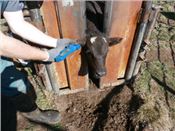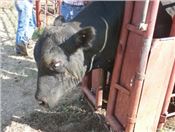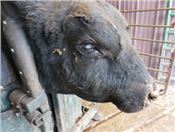What Should You Do To Prepare Cattle For Pinkeye In 2015?
MT. VERNON, MO.
The $64 question each year for cattle producers is: “What should I do to prepare for pinkeye?” The summer of 2014 was a bad one for many herds of cattle in this part of the state according to Eldon Cole, livestock specialist with University of Missouri Extension.
“Sometimes, following a year of high eye infection rates there is a drop-off in severity the following year or two. If that were 100 percent reliable many cattlemen could relax this year,” said Cole. “Unfortunately, we cannot depend on the cycle every year and some herds and even some pastures on a farm may be chronic problems with pinkeye outbreaks every year.”
VACCINATION OPTIONS
There are numerous strains of pinkeye. According to Cole, we historically have not consistently been able to use a vaccination program to eliminate the problem.
In some cases, autogenous vaccines have been developed by veterinarians from cultures taken from an individual’s herd. These have given better protection. Although, vaccinations do not totally eliminate the problem, most agree they reduce the severity and shortens recovery time.
“Vaccines available usually carry the claim they protect against more than the common Moraxella bovis organism. They should give a broader range of protection,” said Cole.
Recommendations from the various companies should be followed closely as some need a booster in 3 to 4 weeks. Some recommend an annual booster and the initial vaccination usually should not be given before calves are three to six weeks of age.
Some labels caution to vaccinate as much as six weeks prior to pinkeye season. However, according to Cole, the "pinkeye season" varies from year to year.
“A relatively new concept in the pinkeye battle is an implant product that has an immediate release and a second one that is activated later serving as a booster,” said Cole.
Vaccine prices range from around one dollar per head to almost three dollars per head.
“When you consider the performance reduction and the current value of cattle, vaccinations should be an economical investment this year, especially if you consistently have outbreaks,” said Cole.
PREVENTION STEPS
Cattle producers still need to follow the usual practices such as controlling flies, reducing irritation from weeds, stems, seedheads and dust to name a few. Cole says it is vital to watch cattle closely, especially if your herd has the problem year after year.
Remove affected animals promptly, if possible from the herd and treat them based on your veterinarian's recommendation. Cole says it is also a good idea to use an isolation pasture, so affected animals do not expose herd mates.
There are other steps that can also make a difference. For example, keep the herd in good nutritional shape from an energy, protein, vitamin and mineral standpoint.
Cole says it is also a good idea to maintain good records regarding what animals break with pinkeye. This could help identify cattle in your herd that seem more tolerant to eye infections.
“Seek the advice of your veterinarian on their recommendations to prevent pinkeye. It is important, and it can impact your wallet. Consider that pinkeye can lead to a loss of 50 pound of weaning weight. It can also cause a price discount for cattle showing damaged eyes, and the loss of replacement bulls and heifers due to a significant eye injury,” said Cole. ∆

Applying the implant vaccination for pinkeye.

Example of pinkeye

Example of pinkeye